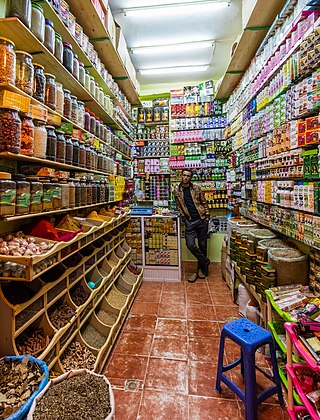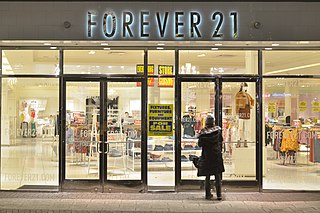Related Research Articles

Shopping is an activity in which a customer browses the available goods or services presented by one or more retailers with the potential intent to purchase a suitable selection of them. A typology of shopper types has been developed by scholars which identifies one group of shoppers as recreational shoppers, that is, those who enjoy shopping and view it as a leisure activity.

Price discrimination is a microeconomic pricing strategy where identical or largely similar goods or services are sold at different prices by the same provider in different market segments. Price discrimination is distinguished from product differentiation by the more substantial difference in production cost for the differently priced products involved in the latter strategy. Price differentiation essentially relies on the variation in the customers' willingness to pay and in the elasticity of their demand. For price discrimination to succeed, a firm must have market power, such as a dominant market share, product uniqueness, sole pricing power, etc. All prices under price discrimination are higher than the equilibrium price in a perfectly competitive market. However, some prices under price discrimination may be lower than the price charged by a single-price monopolist. Price discrimination is utilised by the monopolist to recapture some deadweight loss. This Pricing strategy enables firms to capture additional consumer surplus and maximize their profits while benefiting some consumers at lower prices. Price discrimination can take many forms and is prevalent in many industries, from education and telecommunications to healthcare.

Retail is the sale of goods and services to consumers, in contrast to wholesaling, which is sale to business or institutional customers. A retailer purchases goods in large quantities from manufacturers, directly or through a wholesaler, and then sells in smaller quantities to consumers for a profit. Retailers are the final link in the supply chain from producers to consumers.

A grocery store (AE), grocery shop (BE) or simply grocery is a retail store that primarily retails a general range of food products, which may be fresh or packaged. In everyday U.S. usage, however, "grocery store" is a synonym for supermarket, and is not used to refer to other types of stores that sell groceries. In the UK, shops that sell food are distinguished as grocers or grocery shops.
Sales promotion is one of the elements of the promotional mix. The primary elements in the promotional mix are advertising, personal selling, direct marketing and publicity/public relations. Sales promotion uses both media and non-media marketing communications for a pre-determined, limited time to increase consumer demand, stimulate market demand or improve product availability. Examples include contests, coupons, freebies, loss leaders, point of purchase displays, premiums, prizes, product samples, and rebates.
Discounts and allowances are reductions to a basic price of goods or services.

A variety store is a retail store that sells general merchandise, such as apparel, auto parts, dry goods, toys, hardware, furniture, and a selection of groceries. It usually sells them at discounted prices, sometimes at one or several fixed price points, such as one dollar, or historically, five and ten cents. Variety stores, as a category, are different from general merchandise superstores, hypermarkets, warehouse clubs, grocery stores, or department stores.

Online shopping is a form of electronic commerce which allows consumers to directly buy goods or services from a seller over the Internet using a web browser or a mobile app. Consumers find a product of interest by visiting the website of the retailer directly or by searching among alternative vendors using a shopping search engine, which displays the same product's availability and pricing at different e-retailers. As of 2020, customers can shop online using a range of different computers and devices, including desktop computers, laptops, tablet computers and smartphones.

A closeout or clearance sale is a discount sale of inventory either by retail or wholesale. It may be that a product is not selling well, or that the retailer is closing because of relocation, a fire, over-ordering, or especially because of bankruptcy. In the latter case, it is usually known as a going-out-of-business sale or liquidation sale, and is part of the process of liquidation. A hail sale is a closeout at a car dealership after hail damage.
A catalog merchant is a form of retailing. The typical merchant sells a wide variety of household and personal products, with many emphasizing jewelry. Unlike a self-serve retail store, most of the items are not displayed; customers select the products from printed catalogs in the store and fill out an order form. The order is brought to the sales counter, where a clerk retrieves the items from the warehouse area to a payment and checkout station.

Once the strategic plan is in place, retail managers turn to the more managerial aspects of planning. A retail mix is devised for the purpose of coordinating day-to-day tactical decisions. The retail marketing mix typically consists of six broad decision layers including product decisions, place decisions, promotion, price, personnel and presentation. The retail mix is loosely based on the marketing mix, but has been expanded and modified in line with the unique needs of the retail context. A number of scholars have argued for an expanded marketing, mix with the inclusion of two new Ps, namely, Personnel and Presentation since these contribute to the customer's unique retail experience and are the principal basis for retail differentiation. Yet other scholars argue that the Retail Format should be included. The modified retail marketing mix that is most commonly cited in textbooks is often called the 6 Ps of retailing.
A marketing channel consists of the people, organizations, and activities necessary to transfer the ownership of goods from the point of production to the point of consumption. It is the way products get to the end-user, the consumer; and is also known as a distribution channel. A marketing channel is a useful tool for management, and is crucial to creating an effective and well-planned marketing strategy.

Retailing in India is one of the pillars of its economy and accounts for about 10 percent of its GDP. The Indian retail market is estimated to be worth $1.3 trillion as of 2022. India is one of the fastest growing retail markets in the world, with 1.4 billion people.
Trade marketing is a discipline of marketing that relates to increasing the demand at wholesaler, retailer, or distributor level rather than at the consumer level. However, there is a need to continue with Brand Management strategies to sustain the need at the consumer end. A shopper, who may or may not be the consumer themself, is the one who identifies and purchases a product from a retailer even though they might not purchase the goods at the end of the day. To ensure that a retailer promotes a company's product against competitors', that company must market its product to the retailers as well by offering steep discounts versus competitors. Trade marketing might also include offering various tangible/intangible benefits to retailers such as commissions made for sales.
Fashion merchandising can be defined as the planning and promotion of sales by presenting a product to the right market at the proper time, by carrying out organized, skillful advertising, using attractive displays, etc. Merchandising, within fashion retail, refers specifically to the stock planning, management, and control process. Fashion Merchandising is a job that is done world- wide. This position requires well-developed quantitative skills, and natural ability to discover trends, meaning relationships and interrelationships among standard sales and stock figures. In the fashion industry, there are two different merchandising teams: the visual merchandising team, and the fashion merchandising team.

Everyday low price is a pricing strategy promising consumers a low price without the need to wait for sale price events or comparison shopping. EDLP saves retail stores the effort and expense needed to mark down prices in the store during sale events, and is also believed to generate shopper loyalty. It was noted in 1994 that the Walmart retail chain in the United States, which follows an EDLP strategy, would buy "feature advertisements" in newspapers on a monthly basis, while its competitors would advertise weekly. Other firms that have implemented or promoted EDLP are Procter & Gamble, Food Lion, Gordmans and Winn-Dixie.

The economics of Christmas are significant because Christmas is typically a high-volume selling season for goods suppliers around the world. Sales increase dramatically as people purchase gifts, decorations, and supplies to celebrate. In the U.S., the "Christmas shopping season" starts as early as October. In Canada, merchants begin advertising campaigns just before Halloween, and step up their marketing following Remembrance Day on 11 November. In the UK and Ireland, the Christmas shopping season starts from mid-November, around the time when high street Christmas lights are turned on. In the United States, it has been calculated that a quarter of all personal spending takes place during the Christmas/holiday shopping season. Figures from the U.S. Census Bureau reveal that expenditure in department stores nationwide rose from $20.8 billion in November 2004 to $31.9 billion in December 2004, an increase of 54 percent. In other sectors, the pre-Christmas increase in spending was even greater, due to a November through December buying surge of 100% in bookstores and 170% in jewelry stores. In the same year employment in American retail stores rose from 1.6 million to 1.8 million in the two months leading up to Christmas. This means that while consumers might spend more during this season, they also are given increased employment opportunities as sales rise to meet the increased demand.
Off-price is a trading format based on discount pricing. Off-price retailers are independent of manufacturers and buy large volumes of branded goods directly from them. The off-price retail model relies on the purchase of over-produced, or excess, branded goods at a lower price, thus being able to sell to consumers at a discount compared to other stores which purchased an initial run. Among the largest retailers of this type are TJX Companies and Ross Stores. The model is more common in countries that import fashion-oriented or household goods, as the discount role in producer countries is usually filled by factory outlets or small-scale open-air marketplaces.
The disruptive effect of e-commerce on the global retail industry has been referred to as the Amazon Effect: the term refers to Amazon.com's dominant role in the e-commerce market place and its leading role in driving the disruptive impact on the retail market and its supply chain.
The retail format influences the consumer's store choice and addresses the consumer's expectations. At its most basic level, a retail format is a simple marketplace, that is; a location where goods and services are exchanged. In some parts of the world, the retail sector is still dominated by small family-run stores, but large retail chains are increasingly dominating the sector, because they can exert considerable buying power and pass on the savings in the form of lower prices. Many of these large retail chains also produce their own private labels which compete alongside manufacturer brands. Considerable consolidation of retail stores has changed the retail landscape, transferring power away from wholesalers and into the hands of the large retail chains.
References
- ↑ "Retail leakage".
- ↑ "Sales leakage" (PDF).
- ↑ "Shrinkage".
- ↑ "PCMS Shrinkage".
- ↑ "Revenue leakage" (PDF).
- ↑ "analysis".
- ↑ "retail industry".
- ↑ "Supply and Demand".
- ↑ "Market analysis".
- ↑ "Analysis" (PDF).
- ↑ Neil F. Doherty; Fiona Ellis‐Chadwick (2010-10-12). "Internet retailing: the past, the present and the future" (PDF). International Journal of Retail & Distribution Management. 38 (11/12): 943–965. doi:10.1108/09590551011086000. ISSN 0959-0552.